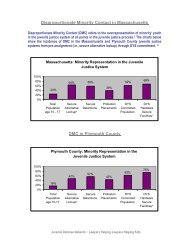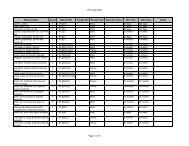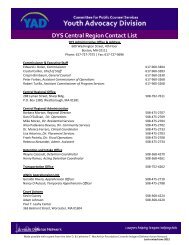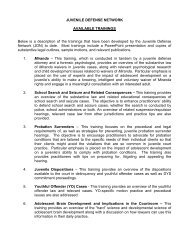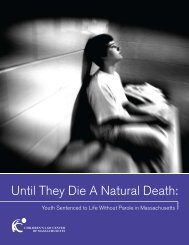Adolescent Brain Development - the Youth Advocacy Division
Adolescent Brain Development - the Youth Advocacy Division
Adolescent Brain Development - the Youth Advocacy Division
Create successful ePaper yourself
Turn your PDF publications into a flip-book with our unique Google optimized e-Paper software.
Joline Krueger, <strong>Brain</strong> Science Offers Insight to Teen Crime, ALBUQUERQUE TRIB., December 8,<br />
2006, http://www.abqtrib.com/news/2006/dec/08/brain-science-offers-insight-teen-crime/ (last visited<br />
Apr. 22, 2010).<br />
• Brief article discussing brain development and question of why adolescents act without thinking.<br />
“Cerebral construction is not complete until around ages 20 to 25, most scientists agree. The<br />
frontal lobe is one of <strong>the</strong> last areas of <strong>the</strong> brain to develop. In <strong>the</strong> adolescent brain, it's barely<br />
firing at all. Without <strong>the</strong> frontal lobe on board, it becomes physiologically harder for a teen to<br />
completely understand <strong>the</strong> future consequences of his or her emotional or impulsive actions,<br />
scientists contend.”<br />
Lee Bowman, New Research Shows Differences in Teen <strong>Brain</strong>s, Scripps Howard, May 11, 2004,<br />
http://www.deathpenaltyinfo.org/new-research-shows-stark-differences-teen-brains (last visited Apr. 22,<br />
2010).<br />
• Explains how while teens’ bodies maybe fully developed, <strong>the</strong>ir brains are nowhere near full<br />
maturity, especially in <strong>the</strong> areas related to culpability.<br />
• “Deborah Yurgelun-Todd of Harvard Medical School and McLean Hospital in Boston has studied<br />
how teenagers and adults respond differently to <strong>the</strong> same images. Shown a set of photos of<br />
people's faces contorted in fear, adults named <strong>the</strong> right emotion, but teens seldom did, often<br />
saying <strong>the</strong> person was angry. … Adults used both <strong>the</strong> advanced prefrontal cortex and <strong>the</strong> more<br />
basic amygdala to evaluate what <strong>the</strong>y had seen; younger teens relied entirely on <strong>the</strong> amygdala,<br />
while older teens (top age in <strong>the</strong> group was 17) showed a progressive shift toward using <strong>the</strong><br />
frontal area of <strong>the</strong> brain. ‘Just because teens are physically mature, <strong>the</strong>y may not appreciate <strong>the</strong><br />
consequences or weigh information <strong>the</strong> same way as adults do,’ Yurgelun-Todd said. ‘Good<br />
judgment is learned, but you can't learn it if you don't have <strong>the</strong> necessary hardware.’”<br />
Claudia Wallis, What Makes Teens Tick? TIME, May 10, 2004,<br />
http://www.time.com/time/magazine/article/0,9171,994126,00.html (last visited Apr. 22, 2010).<br />
• Discusses <strong>the</strong> new technology, processes, and findings relating to brain development (as of 2004).<br />
Cites many of <strong>the</strong> leading brain researchers in <strong>the</strong> field.<br />
• “The very last part of <strong>the</strong> brain to be pruned and shaped to its adult dimensions is <strong>the</strong> prefrontal<br />
cortex, home of <strong>the</strong> so-called executive functions--planning, setting priorities, organizing<br />
thoughts, suppressing impulses, weighing <strong>the</strong> consequences of one's actions. In o<strong>the</strong>r words, <strong>the</strong><br />
final part of <strong>the</strong> brain to grow up is <strong>the</strong> part capable of deciding, I'll finish my homework and take<br />
out <strong>the</strong> garbage, and <strong>the</strong>n I'll IM my friends about seeing a movie.” (4)<br />
Bruce Bower, Teen <strong>Brain</strong>s on Trial: The Science of Neural <strong>Development</strong> Tangles with <strong>the</strong> Juvenile Death<br />
Penalty, SCIENCE NEWS, May 8, 2004,<br />
http://www.phschool.com/science/science_news/articles/teen_brains_trial.html (last visited Apr. 22,<br />
2010).<br />
• A good overview of <strong>the</strong> science involved and its application to <strong>the</strong> juvenile death penalty.<br />
• “‘Our objection to <strong>the</strong> juvenile death penalty is rooted in <strong>the</strong> fact that adolescents' brains function<br />
in fundamentally different ways than adults' brains do,’ says David Fassler, a psychiatrist at <strong>the</strong><br />
University of Vermont in Burlington and a leader of <strong>the</strong> effort to infuse capital-crime laws with<br />
brain science.<br />
Age-related brain differences pack a real-world wallop, in his view. ‘From a biological<br />
perspective,’ Fassler asserts, ‘an anxious adolescent with a gun in a convenience store is more<br />
likely to perceive a threat and pull <strong>the</strong> trigger than is an anxious adult with a gun in <strong>the</strong> same<br />
store.’” (1)





